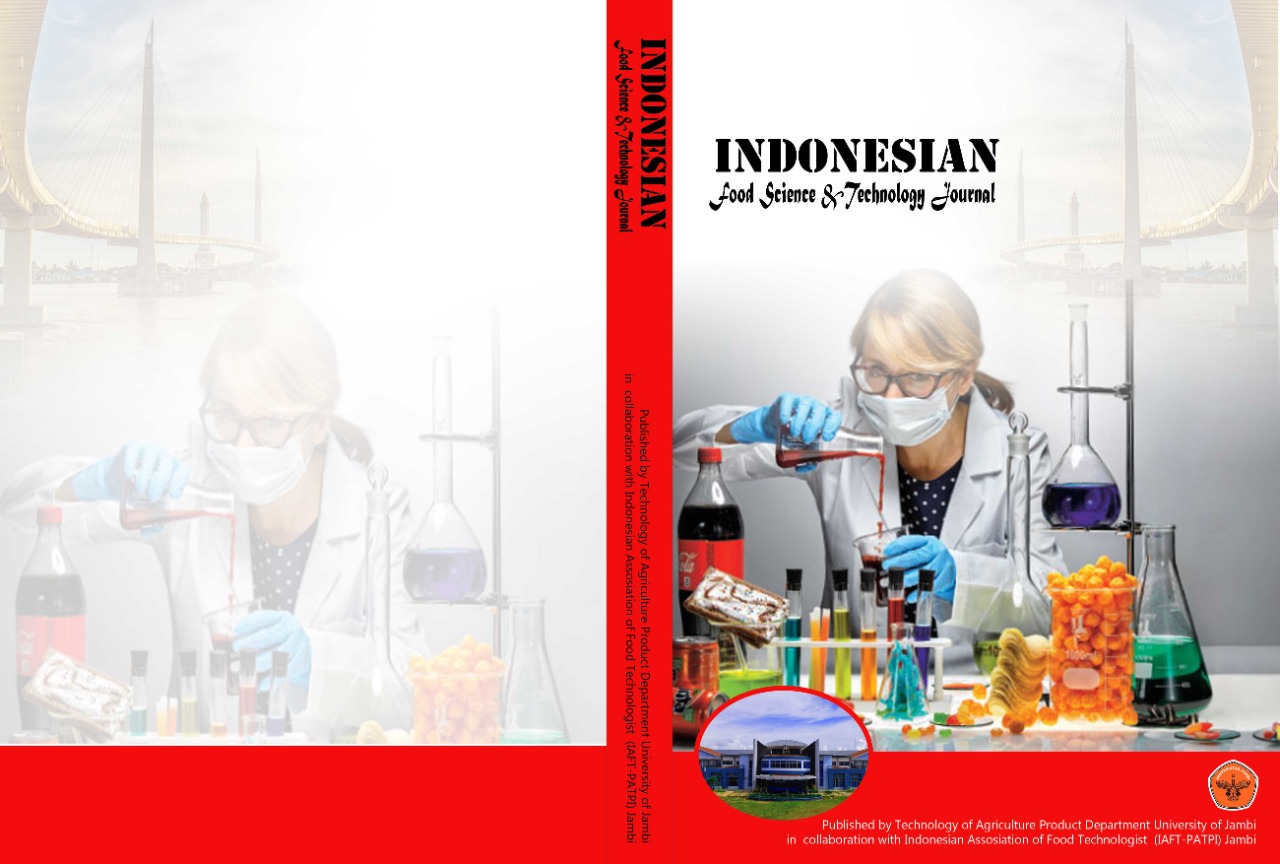Effect of Hydrothermal Treatment on selected Properties of Cocoyam Corm (colocasia esculenta) Flour
DOI:
https://doi.org/10.22437/ifstj.v5i2.14554Keywords:
Cocoyam flour, blanching temperature , soaking time , Cocoyam flour, blanching temperature, soaking time and physicochemical properties.Abstract
The aim of this work is to evaluate the effect of hydrothermal treatment on the physicochemical properties of cocoyam flour. Harvested cocoyam (Colocasia esculenta) was sorted, peeled, washed, sliced, washed, blanched at temperature 60 ̊ C, 80 ̊ C and 100 ̊ C and soaked at different time of 12 hours, 24 hours and 48 hours after then oven dried. The dried samples were milled into flour labelled A, B, and C at three replicates (3×3×3=27) with unblanched and unsoaked sample D as control. The samples were packaged for analysis. Result showed that at temperature 60 ̊ C for soaking time 12 hours, 24 hours and 48 hours, the moisture content are 4.16 %, 3.62 % and 5.01 %, fat 5.22 %, 5.22 % and 4.72 %, crude fibre 0.98 %, 0.99 % and 0.53 %, protein 1.75 %, 1.47 % and 1.61 %. It is concluded that hydrothermal treatment of cocoyam (colocasia esculenta) can modify the physicochemical properties of flour produced. However, the minimum effect occurred at 60 ̊ C compared to 80 ̊ C and 100 ̊ C .thus, the quality of cocoyam flour can be improved using blanching temperature 60 ̊ C and 12 hours soaking time.
Downloads
References
Ekanem, A.M. and Osuji, J.O. (2006). Mitotic index studies on edible cocoyams (Xanthosoma spp and Colocasia spp). African Journal of Biotechnology. , 5(10).846-849.
Suja, G., Susan John, K. and Sundaresan, S. (2009). Potential of Tannia (Xanthosoma sagittifolium (L.)Schott.) for organic production. Journal of Root Crops, 35(1):36-40.
Talwana, H.A.L., Serem, A. K., Ndabikunze, B. K,Nandi, J. O, Tumuhimbise, R., Kaweesi, T., Chumo, E.C. and Palapala, V. (2009). Production Status and Prospects of Cocoyam (Colocasia
esculenta (L.)Schott.). In East Africa. Journal of Root Crops, 35(1): 98-107.
Baruwa, O.I. and Oke, J.T. . (2013). Analysis of the Technical Efficiency of Small-holder Cocoyam Farms in Ondo State, Nigeria. Tropicultura , 30(1): 36-40.
Shiyam, J. O; Obiefuna, J. C; Ofoh, M. C. Oko, B. F. D. and Uko, A. E. (2007). Growth and corm yield response of upland cocoyam (xanthosoma sagittifolium l) to sawdust mulch and n p k 20 : 10 : 10 fertilizer rates in the humid forest zone of Nigeria Con.
Dotsey, P. (2009). The use of Cocoyam, Cassava and Wheat Flour Composite in the Production of rock Cakes, HND Dissertation. Cape Coast, Ghana, 1: 7-40.
Onwueme, I C and Simha T D. (1991). Field Crop Production in Tropical Africa. Netherlands : C T A Edu p276-288.
Bolarin F.M, Olotu F.B, Alfa Saheed and Afolabi R.A . (2018). Effect of Processing Methods on The Functional Properties of Cocoyam Flour . International Research Journal of Natural Sciences , Vol.61:13-17.
Onyeike, E N Olungwe, T and Uwakwe, A A. (1995). Effects of Heat Treatment and Defatting on the Proximate Composition of some Nigerian local thickener. Journal of food chemistry, 53:173-17.
Kwateng,J A and Towler, M J. (1994). A Textbook For Schools and colleges. Macmillan. London: Macmillan Pub.London pp 128-129.
Opara, L. U (2002). Edible Aroids:Postharvest Operation in AGST/FAO. Massey University New Zealand: Danilo ,M (ed).
Food and Agricultural Organaisation FAO. (2006, may 25). www.FAO. org. Retrieved from FAO Satistics www.FAO. org
AOAC (2006). Official Methods of Analysis. Association of Official Analytical Chemists (18th edition), Washington D.C.
Institute of Food Science and Technology IFST, 1992. Shelf – Life of foods – Guidelines for its determination and production. A Publication of the Institute of Food Science and Technology (U.K).
Agoreyo B O, Akiroroh O, Orukpe O A, Osaweren O R and Owabor C N. (2011). The Effect of Various Drying Methods on the Nutritinal Composition of Musa Paradisiaca, Dioscorea Rodundata and Colocasia Esculenta. Asian Journal of Biochemistry, 6 Pp 458 - 464.
Owusu-Darko, P.G; Alistair, P; Omenyo,E. (2014). Cocoyam (Corms and Cormels) An Under Exploited Food and Feed Resource. Journal of Agricultural Chemistry and Environment, Vol 3(1) Pp 22-29.
Adekanmi O. A, James A. A, Grace O. B, Ajekigbe S. O, Ifeoluwa D. B. (2019). Cocoyam Processing: Food uses and Industrial Benefits. International Journal of Scientific & Engineering Research , V10( 9) .
Ogunlakin G O, Oke M O, Babarinde G O and Olatunbosum D G. (2012). Effect of Drying Methods on Proximate Composition and Physico Chemical Properties of Cocoyam. American Journal of Food Technology.
Adejumo, B.A; Okundare, R O; Afolayan, O I and Balogun, S A. (2013). Quality Attributes of Yam Flour (Elubo) As Affected By Blanching Water Temperature and Soaking Time. The International Journal of Engineering and Science., Vol 2 (1) Pp 216 - 221.
Ajala A. S., Ogunsola A. D. and Odudele F. B. (2014). Evaluation of Drying Temperature on Proximate, Thermal and Physical Properties of Cocoyam Flour. Global Journal of Engineering, Design and Technology , 4:13-18.
Chavan,U D and Pawar,V D. (2014). Post Harvest Management and Processing Technology(Cereals, Pulses, Oilseeds,Friuts and Vegetable). Daya publishing house, New Delhi.
Elsie R. L and Darko S. (2010). Production of Cocoyam,Cassava and Wheat Flour Composite rock Cake. Pakistan Journal Of Nutrition, 9(8),810-814.
Jirat T., Sakruedee A. and Pasawadee P. (2006). Chemical and Physical Properties of Flour Extracted From Taro Colocasia esculenta (L) Schott Grown in Different Regions of Thailand, Asia. Scientia Agriculturae, 32: 279-284.
Downloads
Published
How to Cite
Issue
Section
License
Copyright (c) 2022 Kator Asema, Bolanle Adenike Adejumo

This work is licensed under a Creative Commons Attribution 4.0 International License.



